Best EQ Pedal Wordwide Search 2024 - Results
We have curated the best EQ pedal choices for guitar tone sculpting that give you ultimate control over your sound
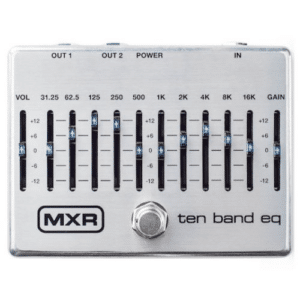
MXR M108S
A 10-band EQ pedal with carefully selected frequency controls for ideal for guitar tone tweaking.
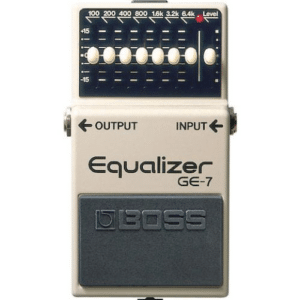
Boss GE-7
Highly regarded for its versatile 7-band EQ sliders, and Boss' tank tough build-quality and reliability.
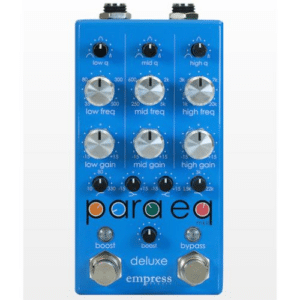
Empress ParaEQ MKII Deluxe
It gives precise tonal control with parametric EQ features, ideal for cutting and boosting frequencies.
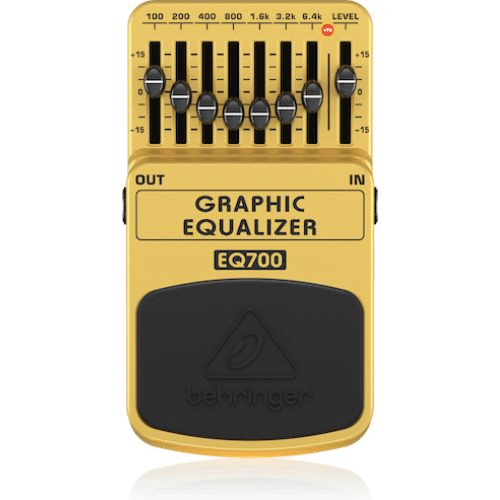
Behringer EQ700
A good value entry-level EQ pedal with 15dB boost or cut per band for versatile tone tweaking at a bargain.
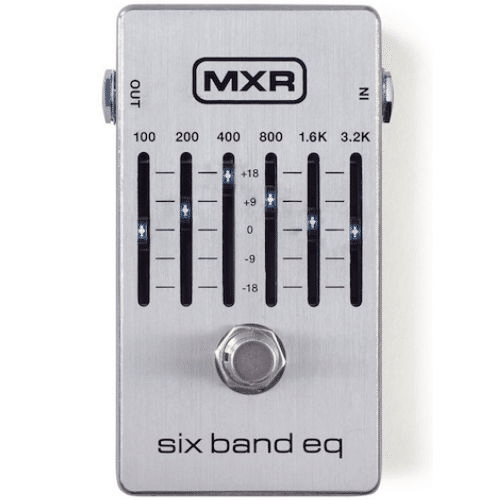
MXR M109S
Compact EQ with pristine audio, true bypass, and +/-18 dB boost/cut capabilities. A suitable mid-priced EQ pedal.
We’re reader-supported. When you click product links on our site, we may earn an affiliate commission at no extra cost to you.
Equalization plays an important role in all aspects of music production and amplified instruments like electric guitars are not exempt from it. As a result, the majority of amps and stompbox effects are bundled with built-in EQ, either through a basic tone knob, 3-band EQ, or other more powerful slider-type EQs.
Because of these built-in EQ effects, many guitarists have skipped standalone EQs, unaware of the advantages of dedicated EQ pedals.
Experienced players agree that a standalone EQ pedal provides better chaining flexibility and tone shaping. Instead of being stuck with built-in EQs’ original signal routing configuration, you can place a dedicated EQ pedal before or after a particular effect or guitar amp.
This opens up a wide spectrum of tone-shaping options, something that would normally not be available on conventional built-in EQ effects.
Whether you want full control over your guitar’s voice or you’re looking to subtly shape your sound to better suit the changing instruments and venues you play at, you’ll find the best EQ pedal for you right here.
Best EQ Pedals 2024 - Detailed Descriptions
MXR M108S
Best EQ Pedal (10-Band)
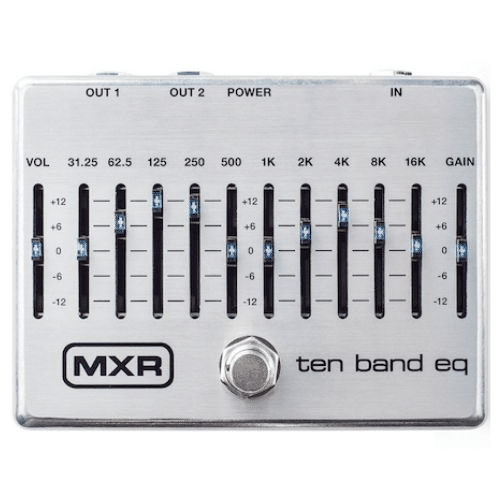
MXR M108S 10 Band Graphic EQ Pedal
Guitarsite Expert Opinion
Its 10-band EQ and top-notch circuitry provide comprehensive tone control. Its lightweight brushed aluminum enclosure ensures durability for gigging musicians. Each carefully selected frequency allows for precise adjustments, making it a perfect tool for guitarists seeking meticulous control over their tone through precise cuts and boosts.
We’re reader-supported. When you click product links on our site, we may earn an affiliate commission at no extra cost to you.
Jim Dunlop has been making top-of-the-line gear for over 50 years, and this M108S EQ pedal is a testament to that. This 10-band EQ delivers tone-shaping at full capacity.
The brushed aluminum enclosure is lightweight and can withstand the demands of gigging in different venues. The foot switch is also solid and could last for a long time.
This is the update for the previous version–MXR M108 10 Band Graphic EQ. It retains all the qualities of the previous one but with top-of-the-line circuitry. This ensures the faders are responsive to frequency nuances and true hardwire bypass switching unadulterated by noise.
As a 10-band EQ, you will have enough frequencies to play with at a broad spectrum. Each of the ten carefully selected frequencies allows you to make precise changes to your sound, be it subtle adjustments to match the venue or significant adjustments to change your guitar sound completely.
Look no further if you’re obsessed with dialing the right amount of cuts and boosts. The MXR M108S 10 Band EQ is the perfect tool for that.
Pros:
- Tone shaping at any spectrum
- Solid aluminum enclosure
- Good visual monitoring
Cons:
- Might be too high-end for some
- Takes up a lot of space
Specifications: | |
|---|---|
Type: 10-Band | Power Supply: 18 V DC |
Inputs:: 1 x 1/4″
| Outputs: 2 x 1/4″ |
Bypass: True Bypass | |
Boss GE-7
Best EQ Peal 7-Band
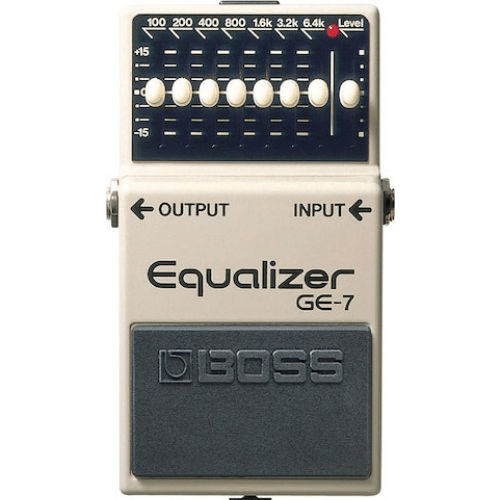
Boss GE-7 7-Band EQ Pedal
Guitarsite Expert Opinion
It balances convenience and versatility, offering 7-band EQ sliders in a compact stompbox design. Endorsed by notable guitarists, it ensures precise frequency adjustments with an additional level control slider. While some noise issues persist, it remains a reliable choice for guitarists seeking quality EQ control without compromising tone or breaking the bank.
We’re reader-supported. When you click product links on our site, we may earn an affiliate commission at no extra cost to you.
With virtuosos like Steve Morse, Marty Friedman, Steve Lukather, and others endorsing their brand, Boss continues to enjoy its status as one of the best guitar pedal manufacturers in the market. As expected with its wide range of effects, Boss has a standalone EQ pedal just for guitarists, the Boss GE-7. This pedal is easily the most popular on this list, and many guitarists, including professionals, used or still use it in their rig.
When basic 3-band EQ is not enough and 10-band EQ is too much work, the Boss GE-7’s 7-band EQ serves as a nice in-between where versatility and convenience meet. The company was able to squeeze a 7-band EQ slider into their regular-size stompbox and even add an 8th slider for level control.
Each slider provides precise boosting or cutting of frequencies, and like other Boss pedals, they are guaranteed to outlast your other gear. This is precisely where the GE-7 stands out, providing great EQ control reliably without compromising tone or jacking up the price.
Some complain that the pedal is a bit noisy when placed in front of the amp, but it does work great when routed through the effects loop. Also, it has more to do with unnecessarily increasing the level setting than the pedal being noisy.
The Boss GE-7 is the safest choice on this list; if you’re not sure which one to get, get it.
Pros:
- Compact and convenient EQ stompbox
- Tank-like build
Cons:
- A bit noisy when near the front of the amp
Specifications: | |
|---|---|
Type: 7-Band | Power Supply: 9V DC |
Inputs:: 1 x 1/4″
| Outputs: 1 x 1/4″ |
Bypass: Buffered Bypass | |
Empress ParaEQ MKII Deluxe
Best Parametric EQ Pedal
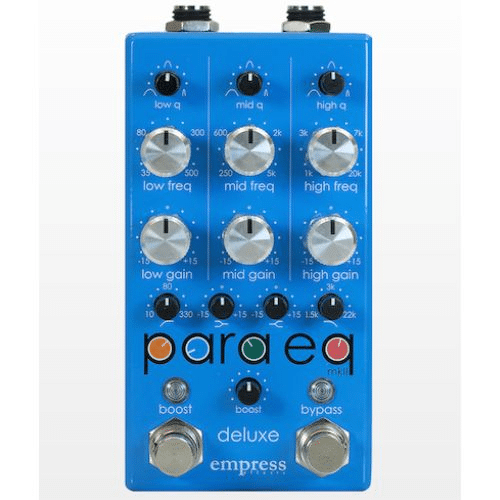
Empress ParaEQ MKII Deluxe Parameteric Equalizer Pedal
Guitarsite Expert Opinion
Its 3-band parametric EQ packs precision, offering versatile control over lows, mids, and highs. Its adjustable Q width and high/low pass filters enhance sculpting capabilities. The pedal’s Analog Baxandal Filters deliver pristine sound, making it a top choice for guitarists seeking premium parametric EQ in a compact design.
We’re reader-supported. When you click product links on our site, we may earn an affiliate commission at no extra cost to you.
Empress Effects is no stranger to sound sculpting. They’ve been producing pedals and modular synths that allow musicians to expand their tonal control.
The ParaEQ MKII Deluxe is truly a testament to that. Don’t let the 3 bands fool you. They enable you to move through the frequency range in sheer precision. Each parameter is like going through different chef’s knives. It’s a feature-packed, parametric EQ pedal for your standard cutting and boosting for lows, mids, and highs.
However, its strengths lie in its ability to change how wide or narrow the Q is and the benefits of utilizing the high—and low-pass filter and boost. Its forte is fully adjustable EQ settings.
This one uses minimal circuitry with active frequency bands that use Analog Baxandal Filters. In simple terms, it’s just the format and circuitry in which these filters are arranged.
Guitar EQ pedals of this kind are on the pricier side, but the pristine sound you get, zeroing in the troublesome frequency ranges, makes them worth buying. It’s arguably the best parametric EQ pedal at a small form factor.
Pros:
- Small form factor parametric EQ
- The ability to use low/high pass and Q adjustments
- Feature-packed, minimal circuitry
Cons:
- Not for beginners
- A bit pricey
Specifications: | |
|---|---|
Type: Parametric EQ | Power Supply: 9V DC |
Inputs:: 1 x 1/4″
| Outputs: 1 x 1/4″ |
Bypass: Buffered Bypass | |
Behringer EQ700
Best Budget EQ Pedal

Behringer EQ700 Equalizer Pedal
Guitarsite Expert Opinion
Provides an affordable option for guitarists seeking entry-level tone shaping. A 15dB boost/cut per band allows adjustments to tackle various frequency issues. While not groundbreaking, it offers more than its price suggests, making it a budget-friendly choice for those exploring EQ pedals before investing in higher-end options.
We’re reader-supported. When you click product links on our site, we may earn an affiliate commission at no extra cost to you.
Going full-spend over mid or expensive pedals is only sometimes ideal. There’s always a need for an affordable graphic EQ pedal that allows any guitarist to try it out first. Then, they can buy more expensive ones.
The very start of the ramp is Behringer’s EQ700 Ultimate 7-Band. It is arguably one of the best graphic EQ pedals for the entry-level market.
You have 15dB of available boost for each of the 7 frequencies, each fader 2x of the previous one. This is enough to cover for boosting or cutting the frequency bands of your guitar. Brittle mids can be turned down, boosting the highs for more air and cutting the low-end gunk.
It’s not meant to be groundbreaking. It does what it does best–a budget-friendly option that where you get more than what you’ve paid for.
Pros:
- Super affordable
- 7 band EQ that does the job
- Solid build
Cons:
- Controls can be too sensitive
Specifications: | |
|---|---|
Type: 7-Band | Power Supply: 9V DC |
Inputs:: 1 x 1/4″
| Outputs: 1 x 1/4″ |
Bypass: True Bypass | |
MXR M109S Six Band
Best EQ Pedal 6-Band

MXR M109S Six Band Guitar EQ Pedal
Guitarsite Expert Opinion
Offers a “mini” alternative to its 10-band counterpart, with a smaller form factor and one In/Out connection. Constructed with durable brushed aluminum, it ensures reliability during travel or gigs. With +/-18 dB boost/cut per band, LED-lit faders, and true bypass, it provides versatile tone shaping for guitarists seeking multi-purpose gain control with pristine sound quality. Highly recommended.
We’re reader-supported. When you click product links on our site, we may earn an affiliate commission at no extra cost to you.
If you think the 10-band version is overkill, consider the MXR M109S Six Band.
It has a 2.5x smaller form factor than the 10-band version. The only difference is that the 6-band version only has 1 In/Out connection. The brushed aluminum feels solid and won’t get any dings or scratches easily in travel or gigs.
You get the same capabilities–pristine audio, true hardwire bypass, and ultra-low noise. Each of the EQ bands delivers +/-18 dB of boost and cut for a wide variety of tone shaping. With this, you can chop off unwanted frequencies, add presence to your guitar solos, and remove feedback. The faders also have bright LEDs that can be seen even in bright conditions.
It’s a great product and an excellent addition for multi-purpose gain control. Highly recommended.
Pros:
- Small form factor with great circuitry
- Solid brushed aluminum for demanding gigs
- +/- dB of boost or cut
Cons:
- Only has 1 Output compared to the 10-band version
Specifications: | |
|---|---|
Type: 6-Band | Power Supply: 9V DC |
Inputs:: 1 x 1/4″
| Outputs: 1 x 1/4″ |
Bypass: Buffered Bypass | |
Boss EQ-200
Versatile Digital EQ Pedal
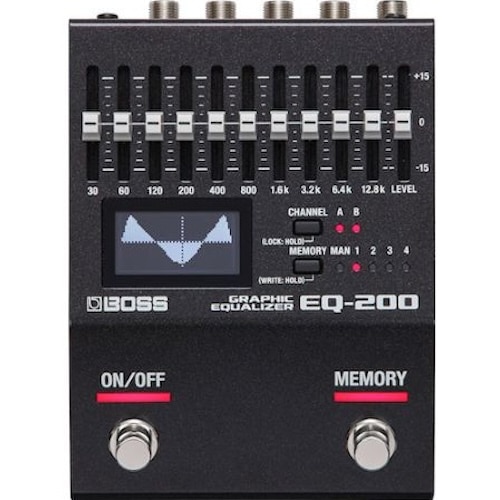
Boss EQ-200 Guitar Equalizer Pedal
Guitarsite Expert Opinion
It condenses live/studio rack EQ features into a compact pedal with an LCD screen, footswitch toggles, and memory presets. Slider movements and Q ranges are displayed on the screen, allowing precise adjustments. Stereo/dual mono I/O options enable parallel/serial setups and wet/dry signal blending, catering to guitarists seeking complete control for versatile tone crafting.
We’re reader-supported. When you click product links on our site, we may earn an affiliate commission at no extra cost to you.
What would it look like if you shaved off the top of a live sound or studio rack EQ, added an LCD screen, and added an on/off and memory footswitch to maximize its capabilities? The Boss EQ 200 would be the closest thing to that.
They’ve refined what using a graphic EQ with extra capabilities other than just the +/-15 dB of cut and boost means. The movement of the sliders and their Q ranges are reflected in the LCD. You can store 4 combinations of EQ settings at the tap of a footswitch.
This means you control your low, high, and mid frequency completely. The Mid gain is especially useful if you want to cut through a dense mix.
For those who want a fully customizable sound, there are a slew of inputs and outputs. Running parallel, the serial is made possible by its stereo and dual mono I/O capabilities. You could also combine wet and dry signals.
This is a good EQ pedal for the guitarist who likes complete control over their guitar signal chain. It’s a great tool for achieving the degree of flexibility needed to create a good-sounding tone.
Pros:
- Total control over your frequency spectrum
- Customizable, programmable capabilities
- Memory expansion
Cons:
- Not recommended for beginners
Specifications: | |
|---|---|
Type: 10-Band | Power Supply: 9V DC or Battery |
Inputs:: 2 x 1/4″, Footswitch
| Outputs: 2 x 1/4″, Headphones |
Bypass: Buffered Bypass | |
Things to Consider in Choosing the Best EQ Pedal
EQ Type
The best EQ pedals have one goal–to allow a person to pick and choose which frequencies get boosted or cut. However, the layout of a particular EQ type isn’t the same. There are for sure other EQ pedal types out there, but the two most popular types of EQ pedals are graphic and parametric EQs. Let’s go through both of them quickly:
Graphic EQ
This is the type of EQ that has sliders, usually on an EQ pedal, ranging from 3 to 10. The individual sliders are assigned to a fixed frequency range. The Q, or bandwidth, is also static. Guitar pedal EQs (Graphic EQs) with sliders are preferred by those who want to easily visualize their EQ settings.
Parametric EQ
A quick search on Amazon or Sweetwater will inform you that this EQ type is more expensive than a graphic EQ pedal. Parametric EQ pedals usually come with low, mid, and high-frequency knobs. The only difference is you can sweep through the frequencies and sometimes even control how wide or narrow the bandwidth is.
Both parametric EQs have strengths and weaknesses. As mentioned, graphic EQ controls give you more bands but are fixed in ranges. Parametric EQs allow you to sweep through the frequencies but are a bit expensive and finicky.
Frequency Band
Most EQ pedals usually offer 3 to 10 frequency bands on average. The number will depend on the amount of control you want over those frequency ranges. So, how do you determine which one’s right for you?
You can start by getting to know your routing. For the most part, it is placed early in the chain, after your compressor and tuner. This way, you want to manipulate the clean signal before it goes through the other effects.
Other times, it is also preferable to simply put it after the distortion and overdrive pedal. Some people prefer controlling the added harmonic content of their fuzz or distortion to make way for other instruments to live.
You could go either way or both. You find some frequencies are way more prominent on many EQ pedals than others. You can use fewer frequency bands for a more “generalist approach” where you tamp down the frequency altogether.
But if you like total frequency manipulation and want everything dialed to the T, use more frequency bands.
Final Thoughts
These are the best EQ pedal choices that will provide you with nuanced control over your guitar’s tone. They will enable you to remove unwanted frequencies, add clarity, and manage feedback if it ever happens.
Which are your favorite EQ pedals, and how do you use them? Let everyone know in the comment section below:
Alexander Briones
Lead Author
Allen Articulo
Contributor: Research and Supplemental Writing


2 thoughts on “Best Eq Pedal Wordwide Search 2024 – Results”
I’m currently looking to buy an EQ pedal but I’m a bit confused.
The Boss GE-7 is $50 cheaper than the EarthQuaker Devices Tone Job but it lets you control 7 different frequencies while the Tone Job only has 3 bands – can anyone explain me why the Boss pedal is so much cheaper when it also gives more tone control?
I think I want the Boss pedal but I don’t understand why it’s so cheap if it’s supposed to be so good.
If you’re looking for more control over your sound at the cost of more time spent tweaking then go for the Boss GE-7. If you’re looking for an easy to use EQ pedal that lacks some versatility, then go for the Tone Job. Hope you pick the one that’s best for your playing style!
Regarding the price, Boss is cheaper mainly because of their efficient ability to mass produce pedals, and since they sell a lot, they can set the price lower compared to builders that have limited reach. It doesn’t necessarily mean that Boss is of lesser quality.